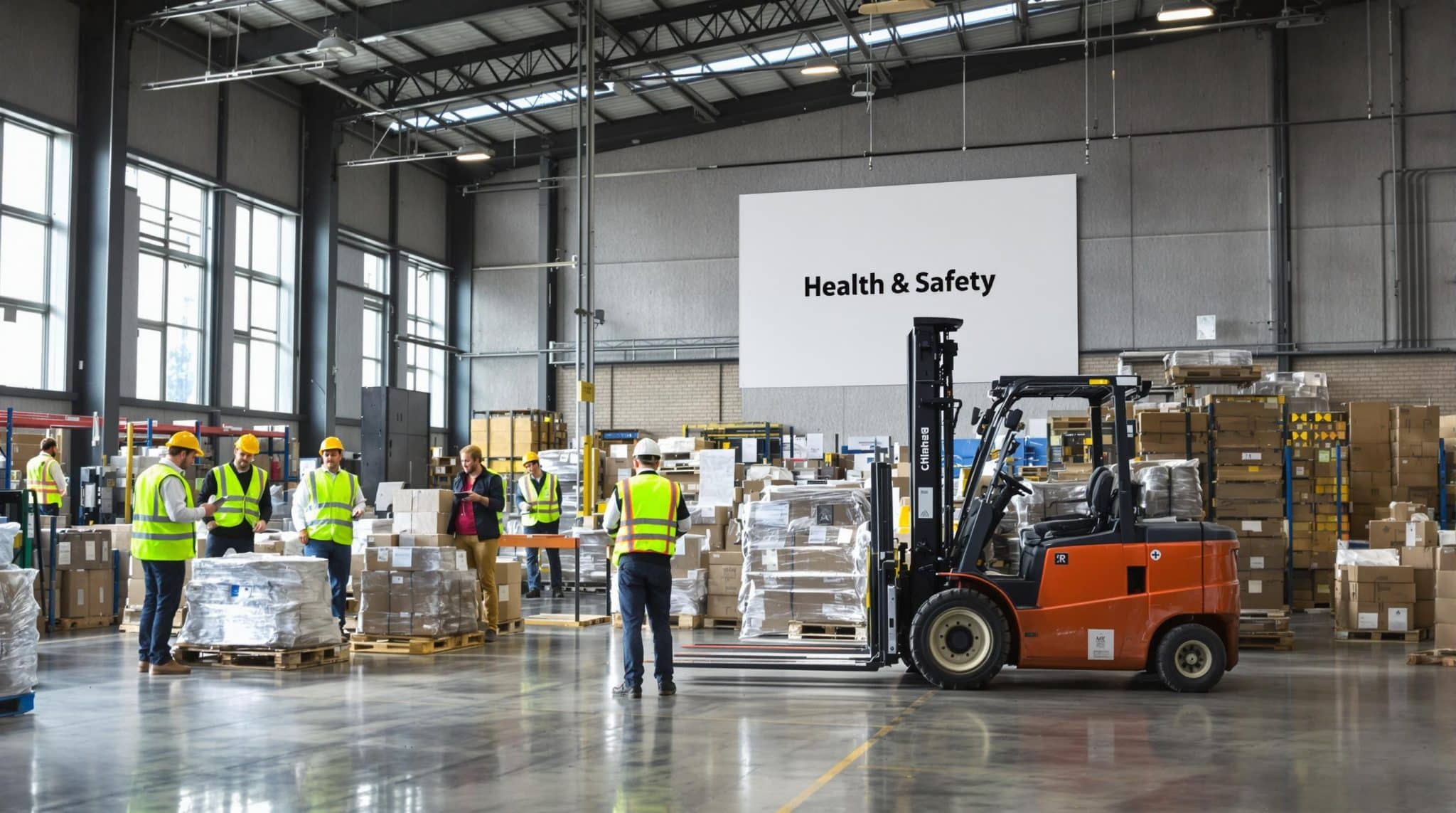
15 Jul Health and Safety in Logistics: Essential Guide for UK Businesses 2025
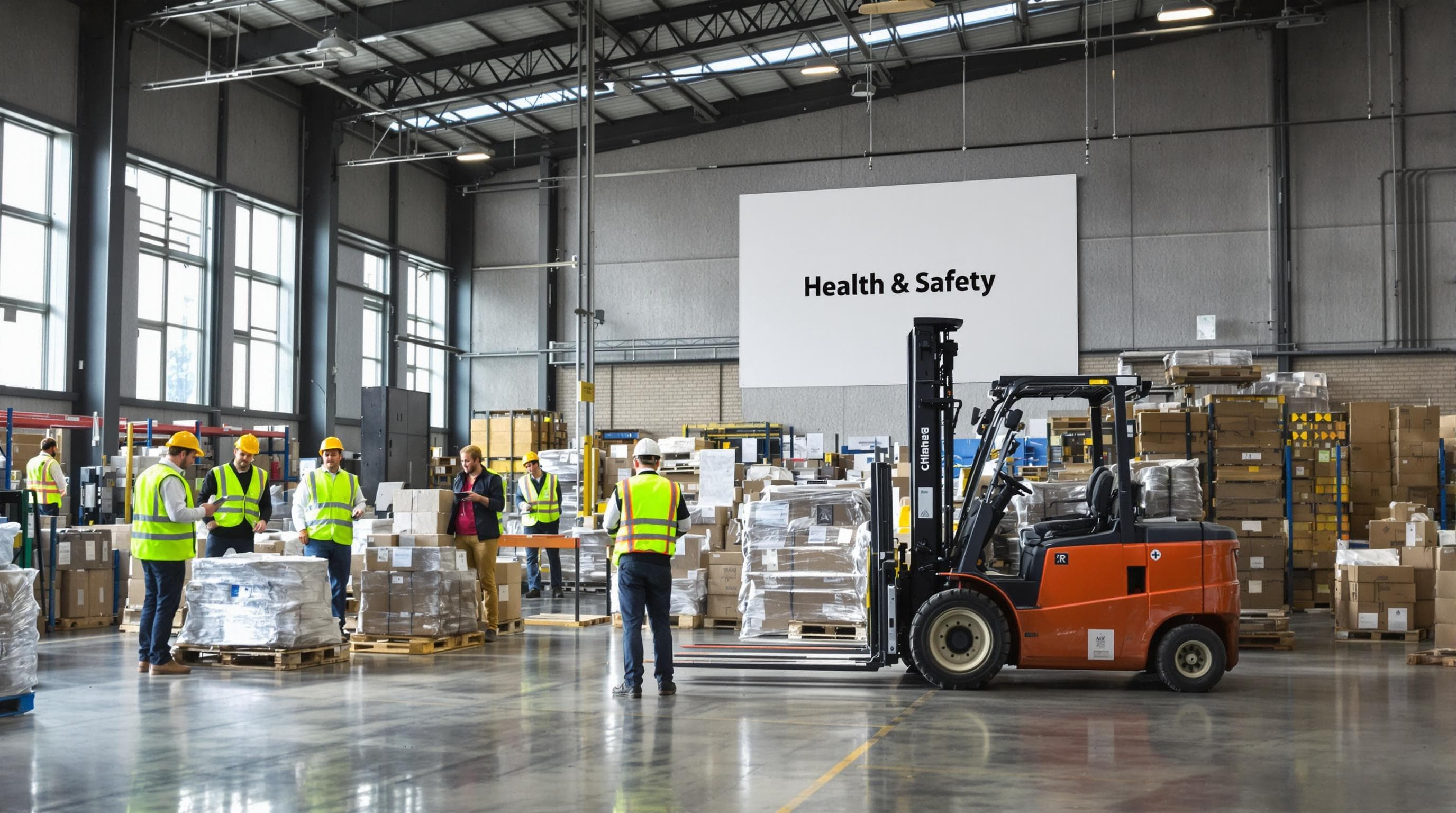
Health and safety in logistics is a pressing challenge for UK companies. Nearly 41 percent of work-related ill health cases in transport and storage come down to stress, depression, or anxiety. Oddly enough, most people only worry about physical injuries and forget just how much mental health gets overlooked. The real risk often hides where nobody expects it, making mental wellbeing just as critical as helmets or hi-vis jackets.
Table of Contents
- Key Health And Safety Risks In logistics
- Legal Requirements For UK Logistics Operators
- Best Practices For Safer Logistics Operations
- Improving Safety For Fast And Time-Sensitive Deliveries
Quick Summary
| Takeaway | Explanation |
|---|---|
| Manual handling training is essential | Implement comprehensive training programmes on proper lifting techniques and provide mechanical assistance to mitigate musculoskeletal risks among warehouse workers and delivery personnel. |
| Strict compliance with vehicle safety standards is crucial | Maintain rigorous vehicle safety checks, regular inspections, and comprehensive documentation to ensure vehicles remain roadworthy and meet operational regulations. |
| Address psychological wellbeing of workers | Develop organisational cultures that prioritise worker mental health through supportive management practices, mental health resources, and recognition of job-related stress factors. |
| Utilise technology for safety improvement | Leverage advanced tracking systems and data-driven analytics to enhance safety standards and risk mitigation in logistics operations. |
| Innovative last-mile delivery strategies | Adopt sustainable delivery practices, such as using low-emission vehicles and developing collaborative networks, to improve efficiency while ensuring worker safety. |
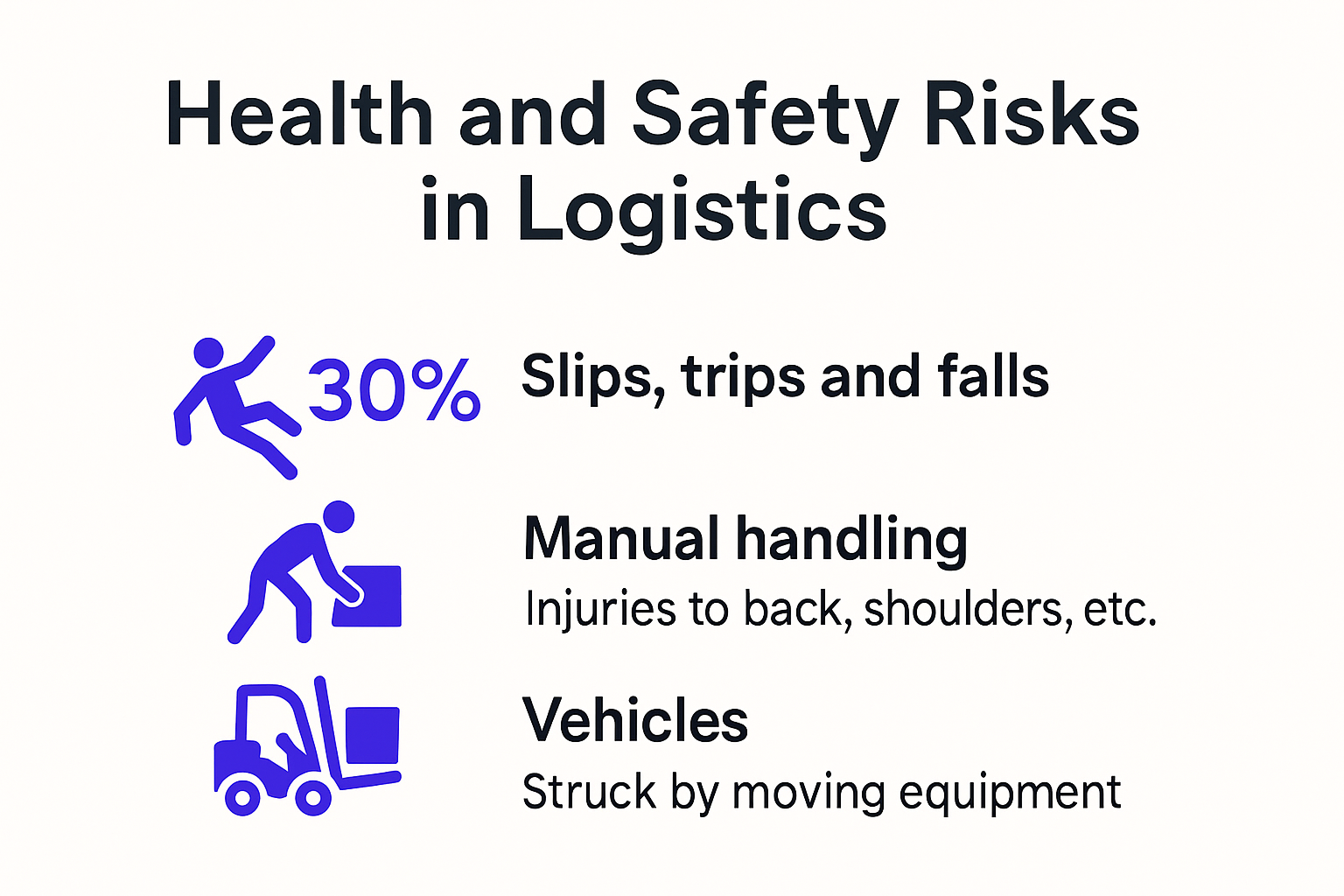
Key Health and Safety Risks in Logistics
Health and safety in logistics presents a complex landscape of potential risks that demand rigorous management and proactive strategies. The logistics sector faces unique challenges that can significantly impact worker wellbeing and operational efficiency.
Manual Handling and Musculoskeletal Risks
Manual handling represents one of the most prevalent health risks in logistics operations. Warehouse workers and delivery personnel frequently encounter tasks involving heavy lifting, repetitive movements, and awkward postures that can lead to serious injuries. Health and safety investigations reveal that musculoskeletal disorders account for a substantial portion of workplace injuries in the transportation and storage sectors.
According to workplace safety research, approximately 36% of work-related ill health cases in transportation and storage involve musculoskeletal disorders. These injuries often result from:
- Lifting and carrying heavy packages
- Prolonged awkward postures
- Repetitive motion tasks
- Inadequate equipment or improper lifting techniques
Employers must implement comprehensive training programmes that educate workers on proper lifting techniques, provide mechanical assistance equipment, and design workstations that minimise physical strain.
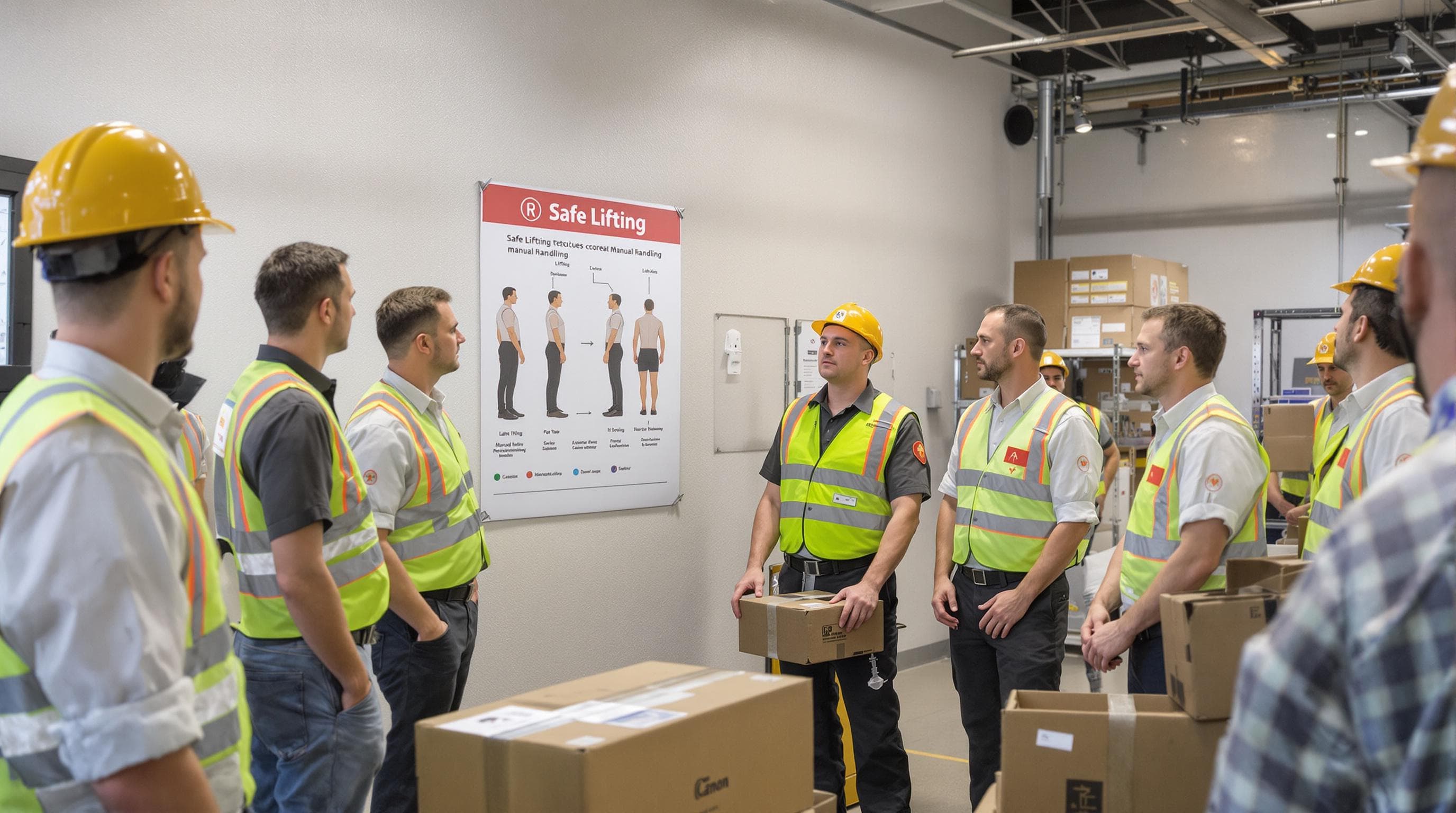
Workplace Transport and Vehicle-Related Hazards
Workplace transport incidents represent another critical safety concern in logistics environments. Occupational safety data indicates that being struck by moving vehicles or experiencing falls during loading and unloading processes are major causes of fatal and serious injuries.
Logistics operations involving multiple vehicles, forklifts, and complex warehouse layouts create inherent risks. Key danger zones include:
- Vehicle movement areas
- Loading and unloading zones
- Pedestrian walkways intersecting with vehicle routes
Effective risk mitigation requires implementing strict traffic management protocols, installing clear signage, establishing designated pedestrian routes, and ensuring comprehensive driver and worker training.
Psychological and Mental Health Challenges
Beyond physical risks, the logistics sector confronts significant psychological health challenges. Workplace health studies highlight that stress, depression, and anxiety represent substantial concerns, accounting for approximately 41% of work-related ill health cases in transportation and storage.
Pressures unique to logistics environments contribute to mental health risks, including:
- High-pressure delivery schedules
- Shift work and irregular hours
- Job insecurity
- Physical demands
- Limited worker autonomy
Addressing these challenges requires a holistic approach that combines supportive management practices, mental health resources, and organisational cultures that prioritise worker wellbeing.
Understanding and proactively managing these key health and safety risks is crucial for logistics businesses. Learn more about our comprehensive courier safety practices to protect both workers and operational integrity.
Legal Requirements for UK Logistics Operators
UK logistics operators navigate a complex regulatory landscape that demands strict compliance with legal requirements designed to ensure safety, operational integrity, and professional standards. Understanding these obligations is crucial for businesses operating in the transportation and logistics sector.
Operator Licensing and Professional Competence
Operating goods vehicles in the UK requires adherence to specific legal frameworks. Government regulations mandate that operators of vehicles over 3.5 tonnes must obtain an Operator’s Licence from the Traffic Commissioner. This licence demonstrates an organisation’s capability to manage commercial vehicle operations through three key assessments:
- Financial standing and economic reliability
- Professional competence in logistics management
- Proper vehicle maintenance and safety arrangements
Drivers must also hold a Driver Certificate of Professional Competence (CPC), which parliamentary research indicates requires completing 35 hours of periodic training every five years to maintain professional qualifications.
Vehicle Safety and Maintenance Standards
Logistics businesses must maintain rigorous vehicle safety standards. Transportation industry guidelines emphasise the critical importance of regular maintenance and comprehensive safety checks. The Driver and Vehicle Standards Agency (DVSA) enforces strict regulations requiring operators to:
- Conduct regular vehicle inspections
- Maintain detailed maintenance records
- Ensure vehicles remain roadworthy at all times
- Implement systematic safety management protocols
Failure to comply can result in significant penalties, including licence suspension and potential legal consequences. Operators must develop robust systems for tracking vehicle conditions, scheduling maintenance, and documenting all safety-related activities.
Compliance and Regulatory Documentation
Successful logistics operations require meticulous documentation and regulatory compliance. Businesses must maintain comprehensive records including:
- Driver qualification certificates
- Vehicle maintenance logs
- Operator licence documentation
- Insurance certificates
- Health and safety risk assessments
Regulatory bodies conduct periodic inspections to verify compliance, making accurate record-keeping essential. Learn more about our comprehensive courier safety practices to understand how professional logistics operators manage these critical requirements.
Navigating the legal landscape of logistics requires a proactive approach, continuous training, and commitment to maintaining the highest standards of professional and safety practices. Businesses that prioritise regulatory compliance not only protect themselves from potential legal challenges but also demonstrate their dedication to workplace safety and operational excellence.
To help summarise the core legal requirements for UK logistics operators, the table below outlines key obligations and corresponding details:
| Legal Requirement | Who/What It Applies To | Key Details |
|---|---|---|
| Operator’s Licence | Operators of vehicles over 3.5 tonnes | Mandatory for operating goods vehicles; demonstrates financial, competence, and safety |
| CPC (Driver Certificate of Professional Competence) | All professional drivers | 35 hours periodic training every 5 years; ensures professional skills stay current |
| Vehicle Inspections & Maintenance | All fleet vehicles | Regular checks, maintain records, ensure roadworthiness |
| Safety Management Protocols | Operators and employees | Systematic safety procedures, ongoing training, risk assessments |
| Record-Keeping | Whole organisation | Maintain licences, insurance, driver and vehicle safety records |
Best Practices for Safer Logistics Operations
Safety in logistics operations requires a comprehensive and proactive approach that goes beyond mere compliance. By implementing strategic practices, businesses can create environments that protect workers, reduce incidents, and enhance overall operational efficiency.
Risk Assessment and Preventative Strategies
Effective safety management begins with thorough risk assessment. Workplace safety guidelines emphasise the importance of systematic identification and mitigation of potential hazards. Logistics operators must develop robust risk assessment protocols that include:
- Comprehensive workplace inspections
- Detailed analysis of task-specific risks
- Regular review and updating of safety procedures
- Involvement of workers in risk identification processes
The Health and Safety at Work Act 1974 establishes a fundamental framework requiring employers to ensure, as far as reasonably practicable, the health, safety, and welfare of all employees. This legislative foundation underscores the critical nature of proactive risk management in logistics environments.
Personal Protective Equipment and Safety Training
Personal Protective Equipment (PPE) and comprehensive training form the cornerstone of workplace safety. Occupational safety research highlights the importance of:
- Providing appropriate and well-maintained protective gear
- Conducting regular training on correct PPE usage
- Ensuring equipment meets current safety standards
- Implementing fit testing and individual equipment assessments
Additionally, the Control of Substances Hazardous to Health Regulations 2002 requires employers to protect employees from hazardous substances through comprehensive risk assessments and exposure control measures.
Technology and Continuous Improvement
Modern logistics safety increasingly relies on technological solutions and continuous improvement methodologies. Advanced tracking systems, wearable safety technologies, and data-driven safety analytics provide unprecedented opportunities for risk mitigation. Key technological approaches include:
- Automated safety monitoring systems
- Real-time equipment performance tracking
- Ergonomic workplace design technologies
- Digital training and simulation platforms
Continuous improvement requires a culture of open communication, regular safety audits, and a commitment to learning from near-misses and incident reports. Learn more about our comprehensive approach to courier safety to understand how professional logistics operators integrate advanced safety practices.
Ultimately, creating safer logistics operations demands a holistic approach that combines legislative compliance, technological innovation, comprehensive training, and a genuine commitment to worker wellbeing. Businesses that prioritise these elements not only protect their most valuable asset their employees but also create more efficient, productive, and resilient operational environments.
The following table provides a summary of best practices and preventative strategies for safer logistics operations, as discussed above:
| Practice | Description |
|---|---|
| Thorough Risk Assessments | Identify hazards, involve staff, update processes |
| Regular Safety Training | Ongoing instruction for all staff, including on PPE and new protocols |
| Provision & Maintenance of PPE | Supply appropriate gear and ensure it is used and cared for properly |
| Implementation of Technology | Use automation, tracking, and analytics for safety monitoring |
| Continuous Improvement & Auditing | Review incidents, near-misses, and update procedures |
| Open Communication Culture | Encourage reporting and dialogue about safety concerns |
Improving Safety for Fast and Time-Sensitive Deliveries
Time-sensitive deliveries present unique challenges in the logistics sector, requiring a delicate balance between speed and safety. The increasing demand for rapid courier services necessitates innovative approaches to protect workers and maintain operational integrity.
Load Security and Vehicle Safety
Health and Safety Executive guidelines emphasise the critical importance of load security during fast-paced delivery operations. Historical data reveals significant risks associated with improper load management, with unsecured loads causing 3 deaths and 160 major injuries in the UK freight industry during 2009/10.
Key strategies for ensuring load safety include:
- Implementing rigorous load securing protocols
- Conducting pre-delivery vehicle safety inspections
- Using appropriate restraint systems
- Training drivers in load stabilisation techniques
The Department for Transport’s Code of Practice provides comprehensive guidance for logistics operators, highlighting the need for systematic approaches to load management and vehicle safety.
Motorcycle and Urban Delivery Safety
Transport for London research reveals critical safety challenges for motorcycle couriers. Despite representing only 2.6% of vehicle kilometers, motorcycles were involved in approximately 27% of deaths and serious injuries from 2017 to 2021.
To address these risks, logistics companies must:
- Implement comprehensive rider safety training
- Provide advanced protective equipment
- Develop route optimization strategies
- Establish strict vehicle maintenance protocols
- Create fatigue management systems
Sustainable and Safe Last-Mile Delivery Practices
Department for Transport recommendations highlight the need for innovative approaches to last-mile delivery safety. The sector must consider broader strategies that balance efficiency, worker protection, and environmental considerations.
Emerging approaches include:
- Utilising electric and low-emission vehicles
- Implementing advanced route planning technologies
- Developing collaborative delivery networks
- Creating consolidated urban delivery hubs
Learn more about our streamlined delivery safety practices to understand how professional logistics operators manage time-critical delivery challenges.
Successful time-sensitive delivery operations require a comprehensive approach that prioritises worker safety, technological innovation, and adaptive strategies. By embracing these principles, logistics businesses can meet increasing customer expectations while maintaining the highest standards of operational safety and efficiency.
Frequently Asked Questions
What are the main health and safety risks in logistics?
The key risks include manual handling and musculoskeletal disorders, workplace transport incidents, and psychological challenges such as stress and anxiety.
What legal requirements must UK logistics operators comply with?
Logistics operators are required to obtain an Operator’s Licence, ensure drivers hold a CPC, maintain vehicle safety standards, and keep comprehensive records for regulatory compliance.
How can I improve the safety of my logistics operations?
Implement thorough risk assessments, provide regular safety training, maintain personal protective equipment (PPE), leverage technology for safety enhancements, and foster a culture of continuous improvement.
What strategies exist for safe last-mile delivery?
Effective strategies include utilising low-emission vehicles, implementing advanced routing technologies, ensuring load security, and creating collaborative delivery networks to balance speed and safety.
Create a Safer, More Reliable Logistics Operation Today
If the growing pressures around health and safety in logistics are keeping you up at night, you are not alone. Many logistics businesses struggle with manual handling risks, strict vehicle regulations and the hidden toll of workplace stress, just as explored in our essential guide. The stakes are high. Failing to meet safety standards or address mental wellbeing can directly threaten your workforce and reputation.
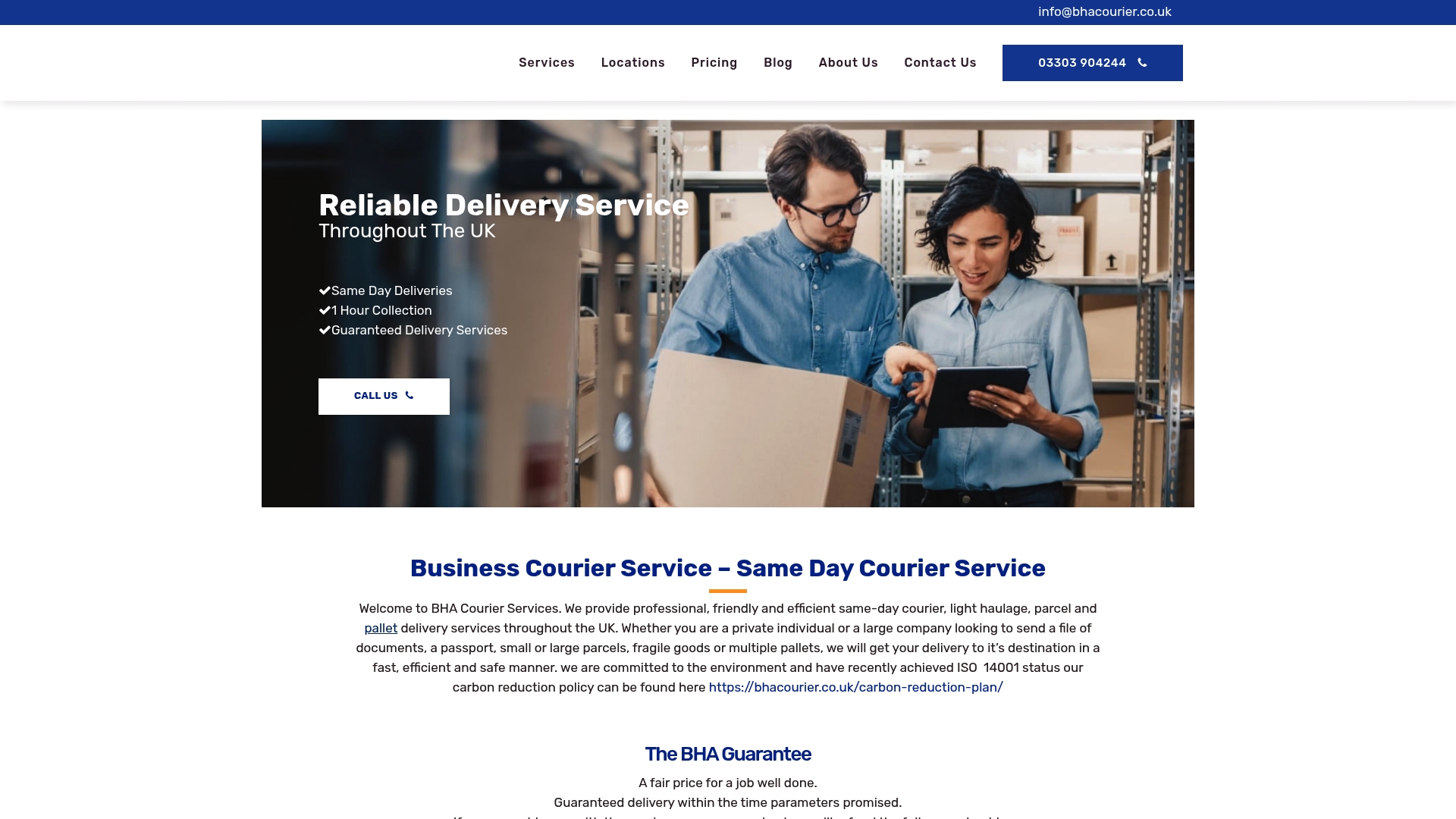
At BHA Courier, safety and reliability are at the core of every service we provide. Whether you are looking for secure same-day delivery, help with complex compliance, or safe and swift transport for sensitive items, our guaranteed courier solutions are designed to support your business goals. Trust our ISO 14001 certified network and specialist team to deliver urgent deliveries without compromising on worker safety or regulatory demands.
Take control of your logistics safety and efficiency right now. Visit BHA Courier or explore our expertise in safe and insured courier services. Act today to protect your team and ensure every parcel arrives securely and on time.

Sorry, the comment form is closed at this time.